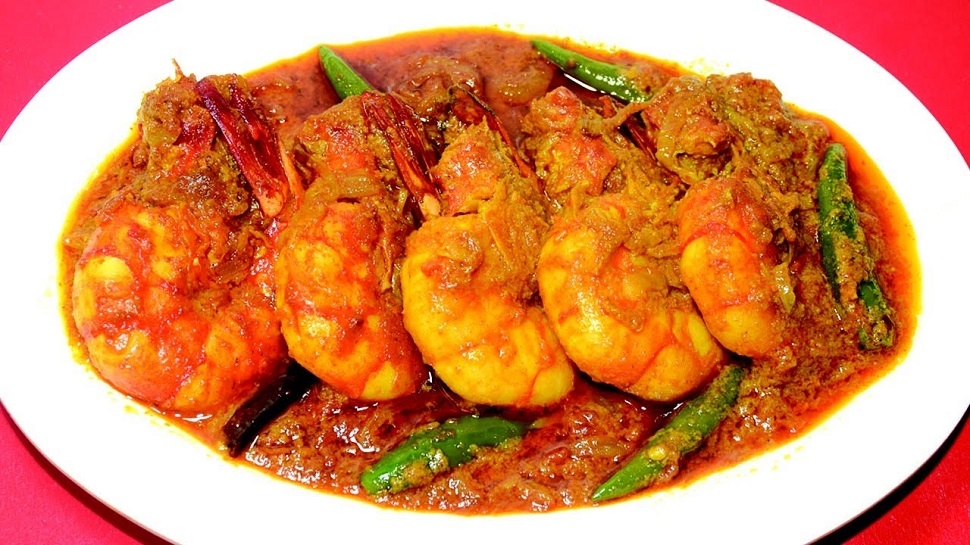Prawn Malai Curry
| Date :01-May-2019 |

By sumit paul:
Bengal’s creamy gift to the gourmets
There’re certain dishes which have such phonetic vibrancy and efficacy that you’re sure to fall in love with them just by hearing their mouth-watering names. Bengal’s Prawn (Chingri in Bengali) Malai Curry is one such culinary wonder that the very mention of it can warm the cockles of connoisseurs’ hearts. Sea-food lovers simply swear by prawns and its other species viz, shrimps, lobsters, prawnzilla (very big prawns of Bahamas, Pacific, Karachi and Brisbane ports; named after Godzilla). By the way, shell-fish (it’s a zoological misnomer because crustaceans aren’t fish) like crabs and prawns along with squids were introduced to the sub-continental palate by the Portuguese hardly 500 years ago.
Before that, Indians would relish simple fish and would consider prawns and crabs as ‘abominable insects’! The Bangla word poka (insect) for prawns is still prevalent among the Bengali Muslims of Bangladesh! Well, coming back to this creamy dish of Bengalis that now figures among world’s top 20 culinary preparations. Apropos, Prawn Malai Curry has the 9th position on the list, 2 notches higher than that of the famed Roghan Josh of Kashmir. The British food historian Alex Toohey is of the opinion that it’s the tastiest Indian dish that defeats all meat preparations from the sub-continent.
An INTELLIGENT dish! What does ‘intelligence’ have to do with food? And why Prawn Malai Curry is called an intelligent dish. Well, it has an interesting story. Prawn and crabs are hard protein like eggs. You may have heard that many people are allergic to prawns, crabs and eggs. These are hard to digest and cause itching and in extreme cases, even vomiting and fainting. In other words, prawns, shrimps and lobsters are heavy on stomach. Intelligent Bengalis found an innovative way to tackle this niggling issue. They introduced coconut milk to prawns and the cumulative culinary effect was magically cool, nay chilled out, to use today’s cool English. The use of coconut milk was also as an antidote for poisons these creatures could have imbibed at sea. Moreover, Bengalis prefer small prawns or shrimps which are found in rivers, unlike lobsters which are sea-dwellers.
Fresh-water river prawns are easy to cook and they have a very mild sweet taste that can only be discerned by the eaters and gourmets. The coconut milk resembles cream/ malai, so this name was given. Small to medium sized fresh river prawns (Gangetic or Hooghly varieties or the Padma, Bangladeshi species) are preferred. Prawns are de-shelled and de-veined. It’s very important. A prawn or lobster must be properly de-veined as this vein carries its waste matter and cobalt and that may cause brain tumour in the long run if the vein is not taken out while cleaning the shell-fish. After de-shelling and de-veining, prawns are washed with vinegar (though, optional) or sirka. Bengalis don’t use Acetic Acid or Vinegar while cleaning the prawns for this preparation. Tamils and Malayalis often wash it with vinegar and see to it that vinegar gets soaked and seeped into the solid flesh of the prawns. A dash of sugar is also put along with pure ghee.
Ghee has this quality to minimise the unnecessary robustness of any preparation and it adds to the final cooling effect. Ghee or clarified butter is also mixed in meat and fish preparations as a natural antidote to constipation. Hard protein causes constipation. So, the combination of coconut cream and 2/3 spoons of ghee wreaks no havoc on the tummies of gourmets and even gourmands. This is one dish that must be eaten with plain rice, preferably Basmati rice. No roti, chapati or zeera rice will do. A couple of important tips can help prepare the most tasty Prawn Malai Curry. First and foremost being, fresh catch. No refrigerated prawns. Conventional mode of cooking in an earthen pot can add to its pristine taste. It’s said that Prawn Malai Curry cooked on gas loses its mojo. Nearly a century ago in Bengal, people would cook it in a handi or matka (tumbler).
The taste used to be otherworldly. Rabindranath Tagore was very fond of Prawn Malai Curry and he could cook it well! His friend and Irish poet William Butler Yeats wanted to taste this dish but couldn’t as the two greats eventually fell out. Britishers, who lived in Calcutta (Oh, Kolkata), loved Prawn Malai Curry. Foreign cricketers, who visited Calcutta, also fell for it. England's Geoff Boycott and Ken Barrington would love Hotel Oberoi Grand’s Prawn Malai Curry. Famous English cricketer Ted Dexter would eat only Prawn Malai Curry during his stay in Calcutta as his wife Susan hailed from Eastern Metropolis. Her dad Tom Longfield captained Bengal in the Ranji Trophy. Bengal won the Ranji Trophy for the first time in 1938-39 under the stewardship of Dexter’s father-in-law. Tom also loved Prawn Malai Curry. To taste it, one must visit Calcutta. You don’t get it so authentic and fresh in any other part of India. l